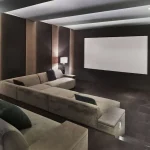Creating a well-thought-out lighting plan is an essential part of any home design project, especially when integrating smart home features. The right lighting can transform a space from stark and uninviting to warm, functional, and stylish. Before you begin, it’s important to assess your needs, the purpose of each room, and the mood you want to achieve.
Understanding the Purpose of Each Space
Different rooms require different lighting strategies. A kitchen used mainly for cooking demands bright task lighting to ensure safety and efficiency. If it also doubles as a social hub, softer, adjustable lighting can help set the tone for entertaining. Bathrooms need a balance between clear, bright light for grooming and the option for softer illumination for relaxation.
Bedrooms benefit from lighting that can shift between calm, ambient tones for winding down and brighter settings for getting ready in the morning. Home offices require focused task lighting but may also benefit from adjustable levels to suit evening activities. Outdoors, lighting might focus on safety, but it can also be used to highlight architectural details.
Layering Light for Function and Style
A successful lighting design incorporates different types of lighting layered to create flexibility.
- Task lighting provides direct illumination for specific activities, such as cooking, reading, or working at a desk.
- Accent lighting highlights architectural details, artwork, or furniture using spotlights, recessed fixtures, or wall washes.
- Ambient lighting offers an overall glow that makes a room feel comfortable and inviting. This can be achieved with ceiling fixtures, wall sconces, and strategically placed floor or table lamps.
Decorative fixtures such as chandeliers and pendant lights can serve as statement pieces, adding character while contributing to general or diffused lighting.
Making the Most of Natural Light
Natural light should be considered alongside artificial sources. Positioning furniture near windows, using light-coloured window coverings, and incorporating mirrors can enhance brightness and create a sense of space. Understanding how daylight moves through your home will help you position fixtures for the best effect.
Embracing Smart Lighting Controls
Smart lighting systems allow you to adjust brightness, colour temperature, and even lighting scenes with the touch of a button or a voice command. They can be linked to other smart features such as automated blinds or music systems, offering complete control from one hub. This flexibility makes it easy to adapt lighting for different moods or times of day.
Planning the Electrical Layout
Rooms with multiple functions may require several separate lighting circuits to accommodate different uses. For example, a combined kitchen, dining, and living area might need six or more circuits, while a gym or office could manage with one or two. Even if you have a clear vision, a qualified electrician is essential to ensure your design is implemented safely and effectively.
Working with Interior Designers
An interior designer can help you create a cohesive lighting scheme that complements your home’s architecture and furnishings. They will consider factors such as fixture style, bulb colour temperature, light quality, brightness, and beam angle to ensure each space is lit in the most flattering way.
Why Good Lighting Design Matters
Thoughtfully planned lighting not only improves the look and feel of a space but also enhances safety, functionality, and energy efficiency. Whether building a new home or renovating, investing time in a detailed lighting plan will ensure every room works as beautifully as it looks.





